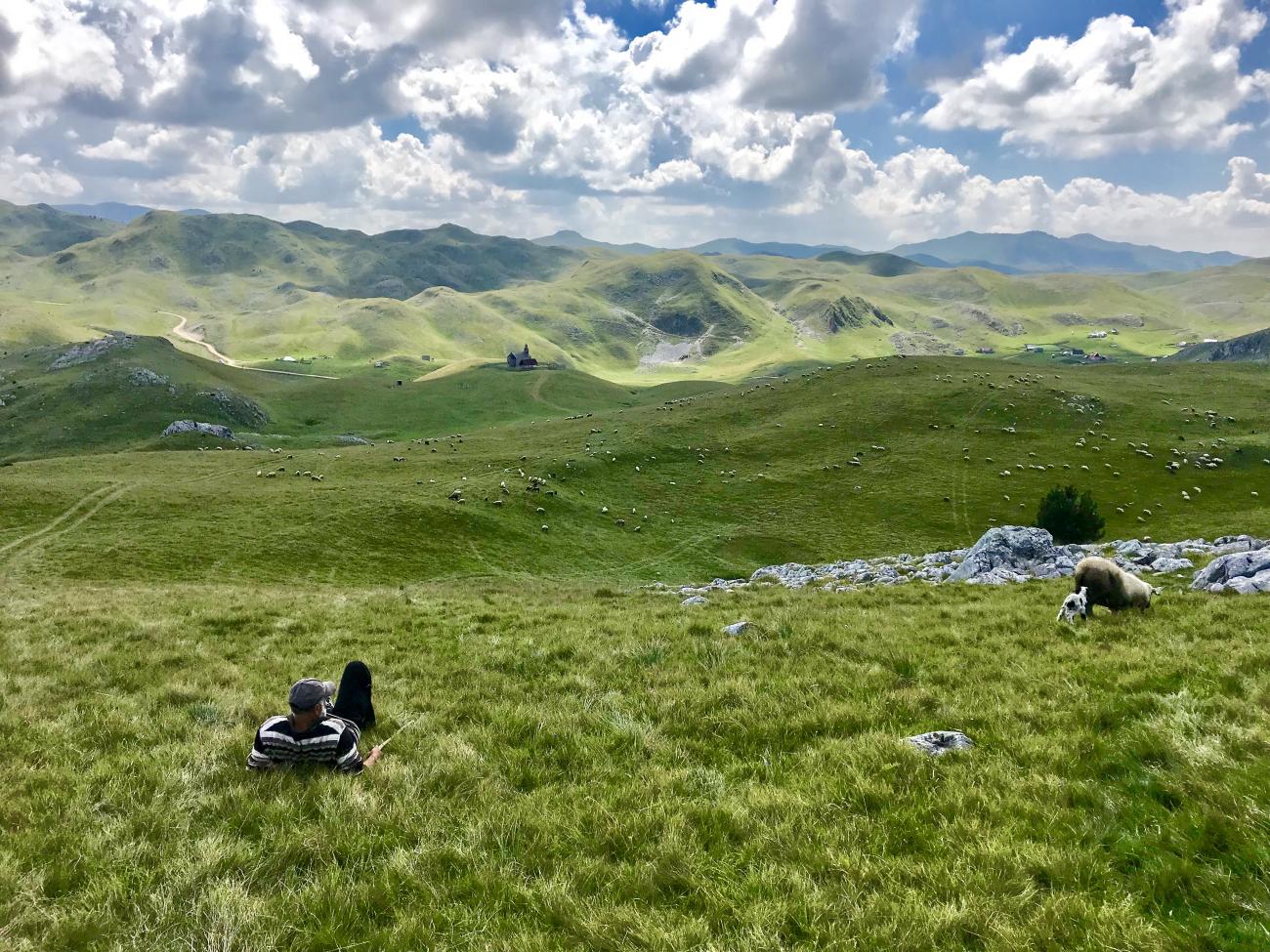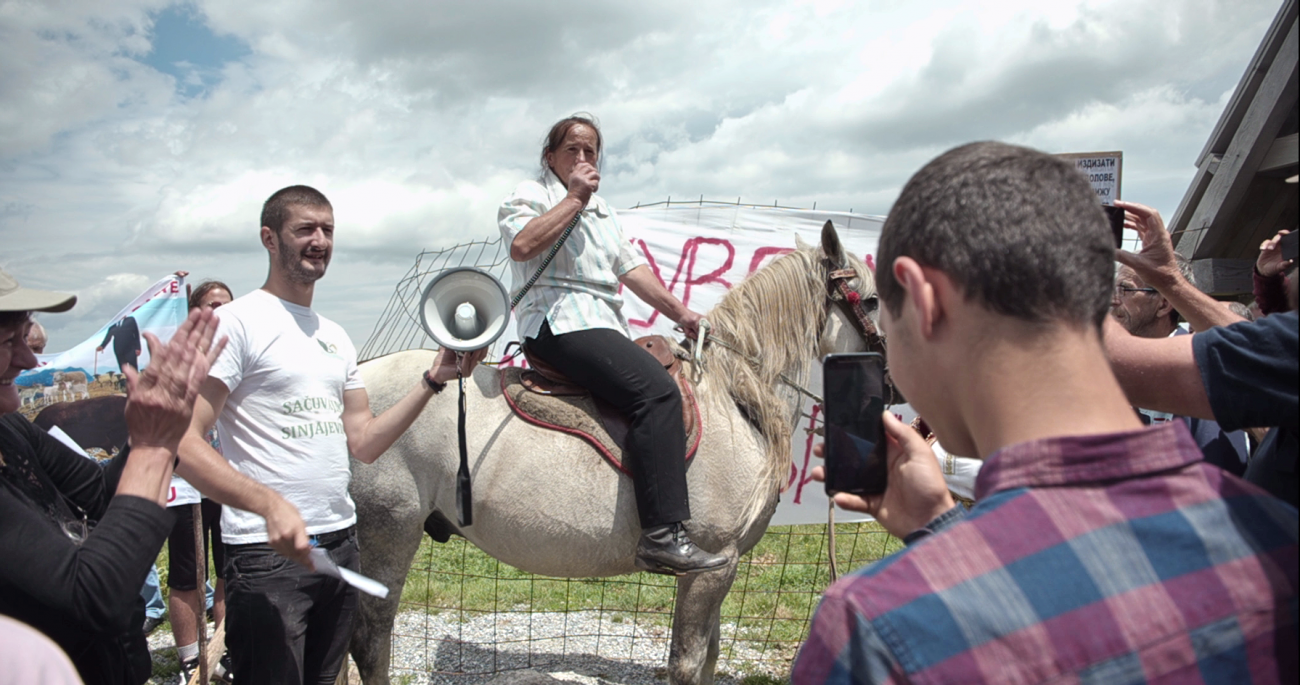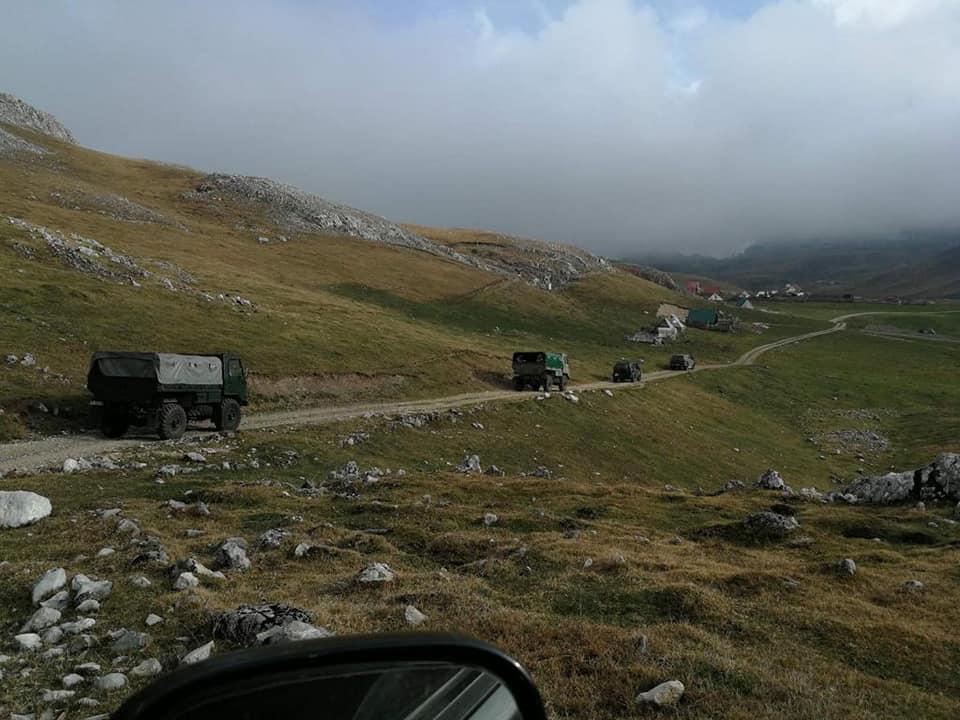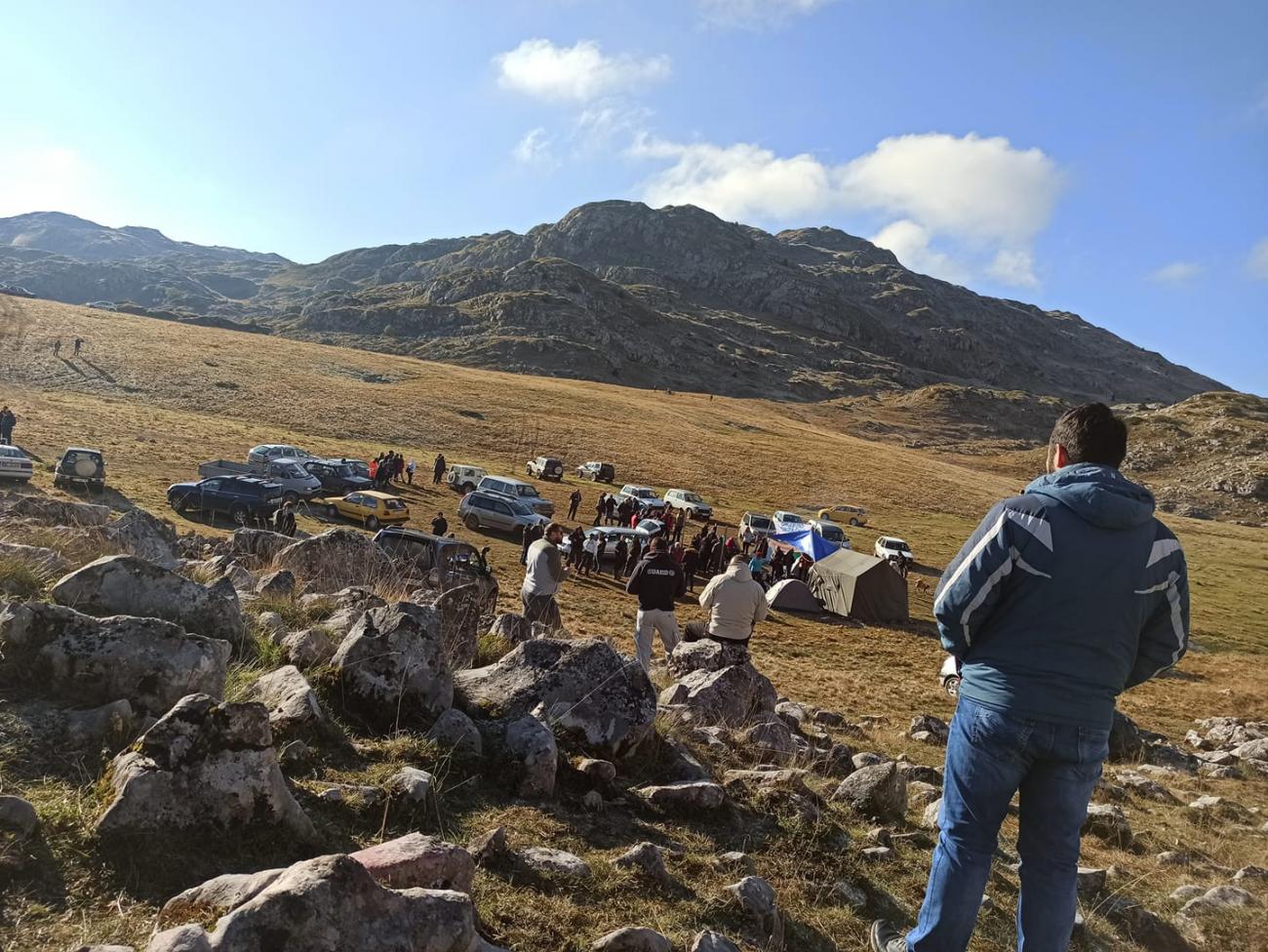In late 2020, a coalition of national environmental and rights’ activists, pastoralists, and international NGOs resisted a military training exercise taking place in the unique Sinjajevina highlands. Following the first phase of the campaign, WRI staff met Pablo Dominguez, an eco-anthropologist from the "Laboratoire de Géographie de l'Environnement (GEODE), CNRS, Université Toulouse (France)" who scientifically advises and collaborates with the Save Sinjajevina Association, and shared with us the significance of this precious place, the movement that led its defence, and their plans for the future.
The campaign website is available here: https://sinjajevina.org/ You can sign a petition in support of the movement here: https://www.landrightsnow.org/get-involved/save-sinjajevina-now/ and support them financially here: https://www.kukumiku.com/proyectos/save-sinjajevina/
What are the Sinjajevina highlands like? Can you describe the landscape, the people, and some of the history?
These highlands are on a huge high plateau. They are next to Durmitor, one of the oldest national parks in the Balkans, which together with Sinjajevina makes nearly 1000sqm of continuous green pasture. It seems to be the biggest mountain pasture in the Balkans, and the second biggest in Europe. It attracts a lot of pastoralists from across the country, who divide the territory between eight tribes, different groups that have traditionally used it. Within each group there are sub-divisions, at clan level. So each village goes onto one area, called a “katun”, or “pastoral quarter”. They have their own rules of managing that area, and they decide between themselves the dates in which they are allowed to come on to the land, respecting the cycle of the plants after the snow. They do so, forbid pasturing during most of the Spring, in order to allow the key species to flower and produce seeds to allow the reproduction of the system before the animals come back up to graze. Unfortunately, there is a lot of depopulation, and it’s a massive territory. There are around 250 families using Sinjajevina – roughly one person per square kilometre. Its not “empty” but there’s a very low demography.
If you look for Sinjajevina on the map, it’s just blank. To find Sinjajevina on the map, look where there are no roads and there you will define its borders – they go all around it. It has no services. No telephone, cable television, water pipes… nothing. They are left there with their luck, and it has been like this for decades. During the socialist period there were some investments and some attempts to collectivise the land, but the projects didn’t work and the people were abandoned, and as industrialisation occurred people started to leave and travel to the cities.
They live very autonomously up there. There are some trails you need to know to reach your katun, and you settle up there with your family. Some people take their animals by foot – sometimes a one-day walk, sometimes a three days walk, on established roads for the cattle. People move by horse very often still, so you have all these guys on horse following their animals – they’re real “Montenegrin cowboys”! They are orthodox Christians, but they are very rough people, like cowboys. They wake up at 3am to get the milk, to feed the animals, they prepare the butter and cheese from this milk… so they are working all the time, and they are tough and rough. They are among the strongest people I’ve ever met. They just need themselves. They don’t get much from the state, they get a little, but mostly they make their own living and the conditions are what they are up there. It’s beautiful.
What is the wider political context?
Until the 1990’s Montenegro was the closest ally of Serbia during the ex-Yugoslav wars. Milo Đukanović, the head of the Democratic Party of Socialists of Montenegro (DPS) is still today president of the country, and has been in all positions of power at the very top, for 30 years. During all these years as leader of the country he led the move westward. The country had been very pro-Russian, and practically intertwined with Serbia to the point of considering themselves as one same nation. Among others they used to write in Cyrillic, the script of the Serbian Orthodox church. But he broke with Milosevic, and then he broke his Russian affiliations. He then joined NATO in 2017, which at the time was locally considered by many, probably a majority, as crazy, because NATO had bombed Serbia and there was and still is a strong relationship today. When NATO bombed Serbia, for Montenegrins it was like they were being bombed themselves. So his turn westward created strong divisions in the country, because of course also a lot of people wanted to look westwards and join the European Union, etc. But at the same time there’s that history behind that made everything feel contradictory and wrong for many of its citizens, who were not even asked in referendum if they approved joining NATO.
Sinjajevina is critical geopolitically speaking. Montenegro is turning westwards, but it is very near the border with Serbia which still has a divided relationship with the West, and also relatively near to Kosovo where there is an important base with American troops, and Sinjajevina, where in 2019 a military ground was inaugurated by NATO allies, including USA troops, is a highland where you could develop a whole airport, a whole base, even if right now they only talk about a training ground.
So what’s the deal with the NATO training exercise?
In 2017 Montenegro joined NATO, without a referendum as said above. In 2018 they started to develop plans to turn Sinjajevina into a military training ground – it was so fast! - and in 2019 Sinjajevina was officially declared a training ground without a debate in parliament. A petition was handed in to parliament from over 6,000 people – which is a lot for a small country of about just half million adults. This petition could have legally triggered a debate in the parliament, but 'the government wasn’t obliged to do so and decided to ignore the thousands of signatures submitted. Then, on 27th September 2019 the military ground was officially inaugurated with troops from the United States, Austria, Slovenia, Italy, North Macedonia, and Montenegro. They were all members of NATO except North Macedonia who became member just a few months later, and the whole creation of this military base just could not feel more like a NATO operation.
Montenegro’s army is very small, just over 2000 soldiers, they don’t seem to need all this land for training. Additionally, they declared the ground without any environmental impact assessment, or social, economic or health assessments publicly available. There is an exception for the military - when something is a question of national security, you don’t need to do an environmental impact assessment, but is there really a threat to national security? On 27th September they detonated half a tonne of explosives on the grasslands that were still being used by people. Also, it is a karst system, the land is full of holes, and the water runs all that detritus into the hydrological system and into the two big rivers of the country, possibly distributing the pollutants well beyond Sinjajevina. People also pick many medicinal herbs from the land which will have been sprayed with I-don’t-know-what products. And this was just the beginning, a little training to show the world. The question is how would this look if a permanent military area is fully developed?
Maybe we could move on to the movement - how did this movement build? Who led the strategy? How do all the pieces fit together?
Over the past centuries, the different tribes using Sinjajevina have been in competition over resources and access to the territory, and because of this, uniting them against this new threat was more difficult than in other circumstance. But some local environmental NGOs started to hear about this devastating plan for local communities and the environment, and people started to speak in their favour. I helped these local communities and activists to establish a strong link to a series of international organisations who defend pastoralists and local communities, and the story started to become known beyond the ex-yugoslav republics. Sinjajevina was the elephant in the room, it was so scandalous. They were planning a training ground within the Tara river basin UNESCO biosphere reserve, surrounded by national parks, even two World Heritage sites, and itself planned with the EU as a Natura 2000 protection area… it’s the part of the country with the highest density of protected areas. There was even a Regional Nature park to be declared by 2020 in Sinjajevina, but the plans stopped in 2018 when the military plan appeared.
So a movement came together, with people from the pastoralist communities and relatively younger activists from all around the country – who were able to use the internet, WhatsApp, emails… – acting as a bridge. But the whole thing was led by the young people from the region of Sinjajevina or linked to the region. A social chain formed, from all the way up in the mountains to all the way down to the capital and to the coast. There was a coalition between two social bodies – the more urban, and the more rural pastoralists, bridged by the young people. So these two social bodies reacted, but especially led by these activists that are abler to communicate between themselves and to the wider society. There were journalists, people connected to the national Green party… so all these people started moving, but outside the country there was no news until, and while doing my ethnographic works in the area about pastoral commons, I accepted to act as a bridge to a network of international NGOs. We started to connect to different international organisations, asking for help. Some key organisations started to take notice, they were touched by the case and couldn’t believe it was happening in Europe. Groups like the ICCA (Indigenous Peoples’ and Community Conserved Areas and Territories) Consortium, the International Land Coalition, Land Rights Now, and the Common Lands Network got involved.
We managed to arrange for a delegation of the European Parliament to meet the pastoralists and activists in February 2019, alongside with some NGOs and environmental scientists, while they were visiting Montenegro as part of their negotiations about Montenegro joining the EU. A blog was started, putting things on YouTube, and started to develop a national and international campaign.
In Summer 2020 the story rose several decibels with the integration of an organization called Land Rights Now. Land Rights Now is a campaigning organisation that works alongside Oxfam, International Land Coalition, and some other partners. They are experts in campaigning, with enough resources to setup an international campaign. Basically by telling the story again and again, the thing started to snowball. They knew how to do web campaigns, with Twitter and Facebook, and they pushed internationally while the local campaign pushed nationally. There were regular online meetings to prepare and keep up the campaign, making videos, and press conferences. And with this, as a kind of snowball effect, the team started to grow and we passed from just a few to several dozen.
As all this was being prepared, the team had the luck that there were national elections taking place at the end of August 2020. They were lucky, or maybe they chose well the different moments! The main political party, led by Milo Đukanović had been in power for 30 years as I said, since the fall of the ex-Yugoslavia, apparently with lots of corruption in between, but made one key and strange or very risky decision. In Spring 2020, the DPS passed a “law of religious freedom”, which mainly meant taking most of the properties away from the Serbian Orthodox Church in Montenegro. The law passed all of the property of the church to the state, unless they could prove that they owned it before the Montenegrin state united with Serbia at the beginning of the 20th century – so this was very largely understood as an attack against this fundamental church in the country. Milo Đukanović was probably trying to win more power and get a church out that he now considered foreign and linked to the opposing state of Serbia so recently in full brotherhood. People really reacted to that, with big demonstrations of people saying “don’t touch our church!”, even people who traditionally voted for the DPS, while the Serbian Orthodox Church always supported the Serbian cause. The Sinjajevina movement spoke to the patriarch of this church, and he attended protests in support of Sinjajevina. So a lot of people were connecting to the protests, and the elections were something of a culmination – it brought everything together. [The president] thought he was going to win the elections, but he passed this religious law in Spring and six months later, he lost control of the government.
There was a party Građanski Pokret URA, supported by The Greens of Europe, that was especially supporting Sinjajevina because it was an environmental issue. But there was also a relatively pro-Serb party (For the Future of Montenegro: ZBCG), who consider themselves Serbs and actually won the most votes in the last elections, and who were also supporting strongly Sinjajevina, because it is in the north, near Serbia, where they ethnically identify mostly as Serbs. This cluster of things started to come together, and translated in the opposition winning the elections.
So the government lost the elections, but the military still planned an exercise – what happened?
The campaign was ready to go in October, but the government was suddenly going to change. The transition period was normally November. The team had everything ready but didn’t expect the government to lose the elections. This became the moment to tell the new government: fulfil their promises! Before the elections these parties said they would support Sinjajevina. So the campaign was ready to shift to that, for when the new government came into power.
Nevertheless, we then heard in early October, that even if the government lost the elections and was now only transitional, the ministry of defence was planning another training exercise on Sinjajevina, from 12th October. It was unbelievable since they had lost the elections! When the government is in transition you’re not meant to make any big new decisions, you wait for the next government to come. So we were asking “who is paying these guys so well?” Of course, NATO was probably very keen to have this territory at its disposal. It didn’t make any sense that the military went up again ordered by an expiring government, but they demonstrated to be keen to start another training.
So with a campaign ready for the 6th October, and the military planning to start on the 12th, with the troop movements starting a few days before that, it just seemed the clash was going to be inevitable. At this point, people from the Montenegrin side of the campaign said they were going to organise a protest camp on Sinjajevina, and work as human shields against the new training. This also happened in part because they were so greatly encouraged by the previous six months of working with international organisations. They saw that they were not alone in this, and I guess that also helped to give them a push.
The national and international teams were lucky, but they prepared all the elements to be lucky too. The Save Sinjajevina Association went up into the mountains on Friday 9th October after launching the campaign on the 6th (press release, press conference, signature collection, video clip on youtube, etc.). The association is a group of people, environmental activists, some children of pastoralists, urban guys who sympathise, friends of the pastoralists… they’re people who are connected with the territory or the cause in some way. It wasn’t led by the pastoralists themselves, they just saw it coming and were very happy the youth were organising and gave them help and support of course. But most of them were young people that came up with their cars, and then some of the pastoralists came in the camp – they stayed with them, brought them food, slept with them, sang traditional songs around the fire… it was minus 10 degrees celsius! Everything culminated in this.
Suddenly, all Montenegro was with them, because its a David and Goliath story. Almost everyone became aware of it and felt identified with the protagonists of the protest. The team produced press releases, press conferences translated into English, Spanish, French, German, Serbian… while people were camping up there and blocking the military operations.
The military were still trying to go up and do mortar shelling, but couldn’t while there were people up there. The old government was still in power, but of course expected soon to leave. The feeling was that the decision-makers in the government wanted to be able to tell NATO “we tried but we can’t hurt anyone”. It looked like a cheap theatre piece – they tried to go in but not harm anyone. If they wanted to they could have taken the police - there was 150 people at its most, but after much less. At some point just a few dozen people and not even. They could have dismantled the camp, beat them up, get them out, and start bombing. But they probably thought that if they did that it could get worse – there was already an international campaign and some focus, and they were leaving their jobs very soon, so they took it relatively softly in reality. Its still a very violent country – journalists get killed – and if they had won the elections and NATO was pushing them strongly like we think, it would have been a very different situation. I am sure.
What they did was fantastic, it was a unique piece of work, but it was reliant on these circumstances. It took the new government months to setup, finally much longer than expected. At first they said they would be ready by the end of October so they would only have to camp for two weeks, but then they said they would declare the new government on a symbolic date in December – it was going to start to snow! People up there said “Just make the government and stop this!” Because the military did try to go up, and kept trying.
But with the core zone of the military ground occupied by protesters, then the military started to go to other places where the Save Sinjajevina Association weren’t camping. When the military went into another area, pastoralists in that area called the people in the camp, and they moved through the trails in the mountains, and placed themselves on the hills around the new site taken by the military. So if they start to use explosives it could reach those peaceful resisters… so there was a collaboration between the pastoralists and activists, a spontaneous, very human, quite heroic, improvised, citizen-based, intelligent resistance to this military use of the pastures – which still had people living on it! And it was because people called the activists who were camped, saying “there are 50 trucks coming in”! The military tried again by going even further, but in the same way locals and external activists prevented it.
What are the next steps for the campaign?
In early December the new government got in place. The new Defence Minister was from the party associated with the European Green Party. She immediately called for the dismantling of the camp, saying the military training exercises on Sinjajevina would stop at least for the time being. So that was the end of the first phase – it was felt as a huge victory, but while the ministers’ words show good intentions, and they’re very welcomed, they’re not yet legally binding. Now in 2021 there is still no protected area that ensures that this never happens again and the different new ministries (particularly three, Agriculture, Environment and Defence) are still denying the Save Sinjajevina association a meeting. So there is a need for a law that cancels the current law that grants this territory a status of “military training ground”. That is still what its status is, officially. They could go up anytime and use the land for training and they would still be protected by the law.
So the next phase that the Save Sinjajevina association is pushing for is a law that cancels the use of Sinjajevina as a military training ground, and then a law that protects the land and its traditional uses that in fact nurture and protect the local ecosystems while granting a sustainable and healthy high-quality production, as well as local livelihoods and continuity to a several centuries old culture if not millenary.
Now there is a new government, with parties that still want to work with the EU to converge. The idea is that by 2022 the military ground is cancelled, and the protected area status is recuperated, but this time integrating more importantly the local community in the decision-making. But they need pressure to make this happen. Now, the ministers of defence, the environment and agriculture – the three that are most relevant to the case of Sinjajevina – are no longer answering calls from the Save Sinjajevina Association. Before the election, and during the camp, they were friends! They came to see them up in the camp at almost 2,000 meters of altitude, to say hello, shake hands, and get their picture in the newspapers. But now they’re not picking up the phone. So Save Sinjajevina needs to make some pressure now.
They had a great campaign, and it mobilized a very and naturally dramatic narrative: some poor people are going to get bombed and they can’t do anything, and no one is helping, and it’s a jewel of biocultural diversity – its scandalous! With this image you can relatively easily get people’s attention. But now the ministry says its cancelled even if it is not really legally-wise, and so it becomes all more complex, more delicate. So now they are starting to work out how to get into the second phase. From “peace guerillas” on the ground last autumn, into a more institutional dialogue, to do things correctly, to protect the people and promote the protection of the landscape and traditional activities. We can’t just sit down and not do anything, and say “everything is fine because its finished”. It is not finished. The work still needs to be finished, and in this sense, science can also contribute greatly.




Comments
There are no comments on this article. Have you got something related to this topic, you'd like to say? Please feel free to be the first person to make a comment.
Add new comment